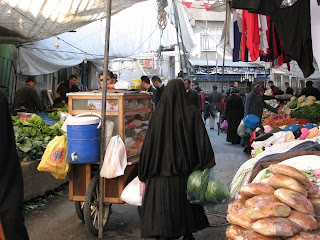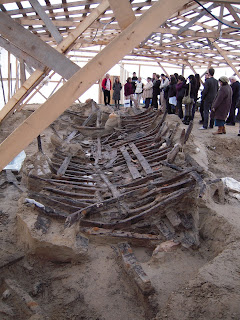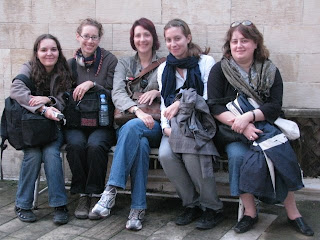
The two of us with Kirk (left) and Duncan on the "Stairs to Nowhere" on top of our building.
A couple of weeks ago we had a lovely outing with a small group of people: Amanda and Ivana from the Center, two of Ivana's friends (one who is a professor of Byzantine art at a university here in Istanbul, the other one a visiting professor of Early Christian art from Athens), Kirk (a fellow Fulbrighter we have mentioned from time to time), and Kirk's college friend Duncan who was visiting for a week. Duncan has an awesome job -- he is originally from horse country in Kentucky, and he lives in London where he works for Sheikh Muhammad, the ruler of Dubai, selecting racehorses for him and helping run his racehorse stables. Pretty cool, right?
Since we had the expertise of three professors at our disposal that day, we asked them to take us on a tour of a lesser-known area of Byzantine Constantinople, outside of the usual (and important) tourist area of Sultanahmet. So naturally they took to us to a Turkish prison.
Have you ever wondered where the saying about horrible Turkish prisons came from? (Yes, it dates back much further than the movie "Midnight Express"). Last week we visited the source of all of the dark stories -- the Ottoman prison called YediKule (Seven Towers). This was the spot where prisoners, both important and expendable ones, were thrown and forgotten during the years of Ottoman rule. Our Serbian friend Ivana reports that even now in eastern Europe, parents frighten their kids into behaving by relating tales of naughty children sent to Yedikule and never heard from again. One of the Seven Towers has a series of small cells built into the curved walls around a central shaft at the bottom of which is the well into which the heads of executed prisoners were tossed unceremoniously after they met their grisly end (known as the "Bloody Well", naturally):

looking up at the cell doors from the "Bloody Well." We stepped out onto that metal platform for a second, but we didn't trust it!
This site was not always such a dark place. In the Byzantine period this area was outside the walls of Constantinople, but there was a massive triumphal arch, the Golden Gate, constructed here along the road to the city, so no one could miss the fact that they were about to enter the capital of a mighty empire. The entire gate, which is largely still standing, was plated with gold (hence the name), and was decorated all over with sculpture. Imagine it shining in the sun! It must have been beyond impressive:

The Golden Gate from atop one of the flanking towers. You can see the triple Byzantine archway that was progressively blocked in over the centuries to make the fortifications more secure, until only a tiny door in the central arch remained.
Eventually, in the reign of the emperor Theodosius (379-95), the city was extended out to this point, walls were built completely enclosing it, and the Golden Gate was incorporated into them as part of the fortifications. Then, under the Ottomans, the stronghold that still stands was constructed in the shape of an octagon, with two of the seven towers being those of the Byzantine Golden Gate. The building served as a military base, which had its own mosque within the walls (you can still see the remains of the minaret in the center of the picture below), as well as a prison.

Legend has it that once you went into Yedikule, you never emerged. Guilty or innocent, prisoners were forgotten, abandoned, and eventually died in the isolated towers. Probably the most famous prisoner here was the Sultan Osman II. He was one of the "mad sultans" who was kept for years in the Cage in the harem of Topkapı Palace while his older brother (Sultan Ahmed, for whom the area Sultanahmet is named) ruled. As long as Osman was locked in the harem, he could not challenge his brother for the role of Sultan. This practice of locking the younger siblings away was considered a humane bit of progress over earlier tradition which dictated that all the younger brothers be executed as soon as the eldest came to the throne.
Locked away from the real world for his entire life in a small series of rooms with only concubines and his mother for company, by the time of his brother's death when he was brought out and made Sultan, he was more or less completely insane and incapable of functioning in any normal way. Rumor has it that he liked to practice with his bow and arrow, using his own men and palace attendants as targets. After only a few short years it was clear that he was nothing but a menace to the empire, and he was deposed by his own guards, the Janissaries, dragged to Yedikule, and executed in a gruesome fashion. Tradition dictated that sultans be strangled with a bowstring, but in this case they added to his punishment by crushing his most sensitive private parts at the same time. That is only one example of a long line of greater and lesser prisoners executed here, or left to rot in the towers.
Gruesome as its past history may be, the site is very beautiful, and we spent several hours wandering around the battlements and the insides of the towers. Care must be taken, however, as some of the modern stairways and balconies are rickety. In fact, Kirk stepped too far out onto the wooden covering over the well (where the heads were thrown), and his foot broke through. Given the fact that the site is not well-maintained overall, and that there are few people around, either tourists (who seem to as a whole miss this amazing spot) or attendants, there is ample opportunity for accidents, which we happily were able to avoid. Here are some pictures of us wandering the grounds:

At the top of the tower with the "Bloody Well" inside.

Inspecting the Ottoman battlements.


Ottoman cannonballs lined up inside the fortress.
Yedikule is probably the best place in Istanbul to go and learn about Byzantine fortifications. Standing on the Golden Gate and looking down, you can appreciate the practically impregnable defenses of Byzantine Constantinople -- of course, the Turks did eventually breach the defenses, but for hundreds of years the Byzantine emperors and their armies were successful in repulsing many invasions. In fact, when the great Attila the Hun swept up to the city with his fearsome hordes, he turned away immediately, unwilling to face a long siege in front of the walls, exposed to the missiles of the Byzantine army. Even when Constantinople fell to the Crusaders of Latin Christendom in 1203, they came in through the sea walls, finding it easier to defeat the legendary Byzantine navy than to attack the well-designed land walls. Although it was too difficult to photograph, from atop the Golden Gate you can study their ingenious four-stage defense structure: a moat, then a small outer wall (short enough to fire projectiles over from the inside walls), then a broad passageway between the outer and inner walls that was used for moving troops around when under siege, then the massive inner walls of which the Golden Gate was a part. The walls extended all the way around the city, including both land walls and sea walls. Here is a picture of some of the better-preserved remains of the Byzantine walls just inland from Yedikule:

Here you can see the inner, main wall (with towers), then the shorter outer wall. The green area in front was the moat.
The area between the inner and outer wall, and the moat area, are now mostly filled with peoples' vegetable gardens, and even a few small impermanent dwellings. Little by little we would like to walk the entire circuit of the walls. We have already walked quite a bit of the sea wall, and a little of the land walls. It's a big project!
Yedikule is really an incredible site in terms of its aesthetic appeal and historical importance. From now on, anyone that comes to visit us will be forced to tour it, probably as their first introduction to the city. So be prepared!

Sunset from the top of the Golden Gate.

The sunset and the walls reflected in the site plan of the fortress. Well done, Peter!






























































